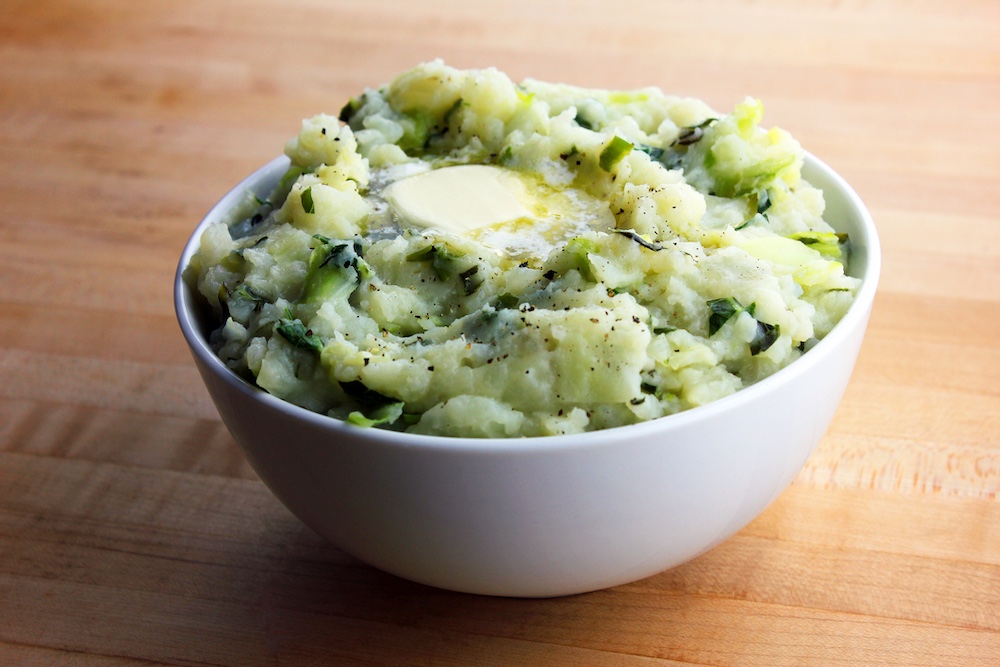Corned beef and cabbage may be synonymous with St. Patrick’s Day celebrations in the U.S., but that dish is more rooted in Irish-American culture than traditional Irish culture. This year, consider two simple, classic Irish potato dishes — boxty and colcannon — for true tastes of Ireland that come with a built-in history lesson.
Ireland’s relationship to the potato is not a simple one. Potatoes are not native to Ireland, but matters of geography, politics, economics and agriculture all played an important part in establishing the humble spud as a dependency crop for much of its working population by the middle of the 19th century. When large percentages of Irish potato crops failed between 1845 and 1852 because of potato blight, causing mass starvation and disease, it heightened tensions between native Irish tenant farmers and the British ruling class, ultimately putting forces in motion that would lead to Irish independence by the early 20th century. Corned beef has never started a revolution, from my research.
Fortunately, preparing or enjoying traditional Irish potato dishes such as colcannon and boxty in honor of St. Patrick’s Day is a much simpler matter. (Arguably simpler, even, than that other St. Patrick’s Day staple: Irish soda bread.) These humble dishes, born out of necessity, as well as the ingenuity of the working classes, help to define the culinary culture of Ireland, much in the way that certain peasant dishes often become emblematic of the cultures and countries that developed them. Given their importance to the culture and spirit of the place, potatoes are the ideal medium for celebrating the patron saint of Ireland.
Let’s take a closer look at these two iconic potato dishes, either of which make an excellent base for your St. Patrick’s Day feast, whether it be alongside a hearty Irish stew, sausages, or if you must, corned beef. Here's how to try each out (potentially paired with green cocktails from Director of Spirits Education Anthony Caporale).
Boxty
Potato pancakes have a spiritual home in many world cuisines and cultures: from Jewish latkes to Swedish raggmunkar, to Irish boxty. Where other starches such as wheat, corn or rice are scarce, potato preparations are used as a sturdy base for meat, seafood or vegetable toppers. From the Irish arán bocht tí, boxty literally indicates “poor house bread.”
For Irish boxty, Director of Operations Frank Proto recommends a starchy potato, like Idaho. Fashion finely grated potatoes into a batter — or when thoroughly drained of their water, a sturdy dough — and then bake, griddle-fry or even boil as dumplings. The hallmark of Irish boxty versus other potato pancake recipes is the fine grain of the potatoes. Boxty may even be grilled thin enough to stand in as a potato crepe wrapped around various fillings.
Colcannon

What better way to dress up mashed potatoes for St. Patrick’s Day than to give them a flash of green? The name colcannon comes from the Irish cál ceannann, meaning “white-headed cabbage.” This would imply a dish that is more cabbage than potato, but colcannon is decidedly a potato dish spiked with hearty greenery; typically cabbage, but kale can stand in for a particularly deep green hue. Like potatoes, both cabbage and kale have sturdy, long storage capabilities, making it easy to imagine how rural families would rely on such a dish well beyond the harvest. Ireland’s primary potato variety of yore, the Irish Lumper, is a white potato that is more waxy than starchy, and so mashed potatoes made from these varieties fare better as smashed, rather than emulsified, providing ideal conditions for hearty mix-ins. Scallions are also a welcome addition to either the cabbage or kale; they fashion another Irish potato dish known as “champ.”
Study global cuisine at ICE in Culinary Arts.






